It’s Thursday and Pandora is anchored in Cienfuegos Cuba about half way down the southern coast of Cuba. Nearby is the Cienfuegos Yacht Club and a throwback to a very different time here in Cuba. It’s now used as a high end spot to cater meals for tourists and it’s hopping most every day. It’s nice to see the club from Pandora. 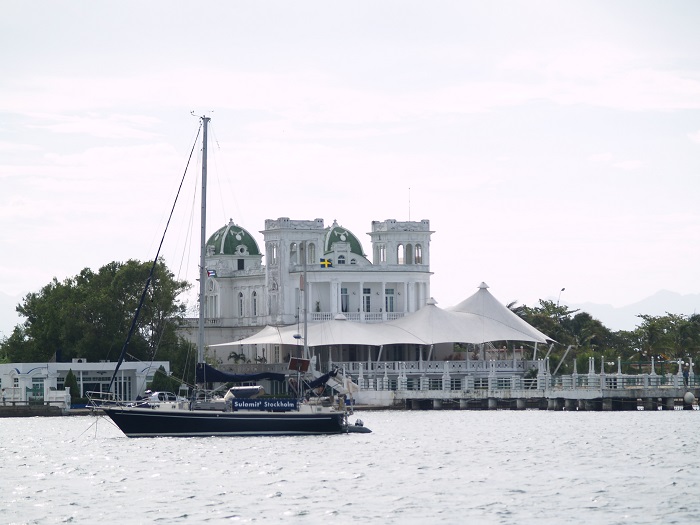 This is the grand view from the street.
This is the grand view from the street.  And, there’s a nice pool and tennis courts on the property.
And, there’s a nice pool and tennis courts on the property. 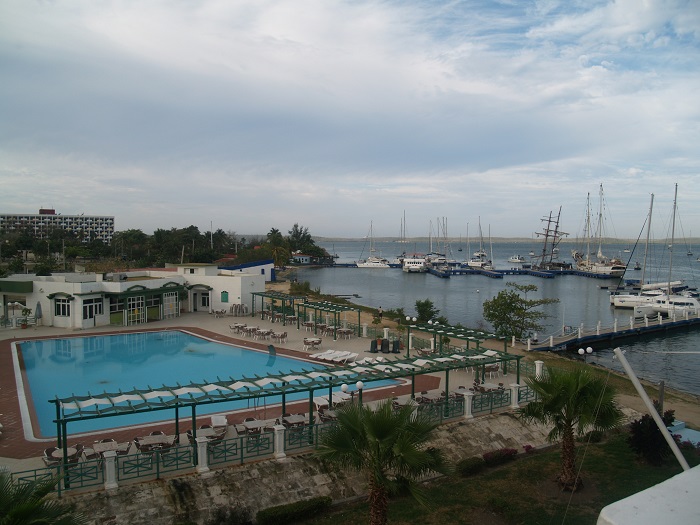 We arrived several days ago and have enjoyed touring this very unique city. After a few weeks of cruising in very remote areas, it is good to be back in “civilization”, although a very different one than Brenda and I are used to. Interestingly, we had been told that boats had to use the marinas and could only anchor out, for a modest fee, with permission. However, we are finding that most all boats anchor as the docks are pretty rough and the electricity isn’t particularly good either. And, as we prefer to anchor out this is good news. Besides, as a practical matter, there are not nearly enough slips to accommodate all the visiting yachts so anchoring “permission” is granted. I think the fee is .25/ft per day. Happily, the holding here is very good in mud and sand unlike that in Santiago where we dragged a few times.
We arrived several days ago and have enjoyed touring this very unique city. After a few weeks of cruising in very remote areas, it is good to be back in “civilization”, although a very different one than Brenda and I are used to. Interestingly, we had been told that boats had to use the marinas and could only anchor out, for a modest fee, with permission. However, we are finding that most all boats anchor as the docks are pretty rough and the electricity isn’t particularly good either. And, as we prefer to anchor out this is good news. Besides, as a practical matter, there are not nearly enough slips to accommodate all the visiting yachts so anchoring “permission” is granted. I think the fee is .25/ft per day. Happily, the holding here is very good in mud and sand unlike that in Santiago where we dragged a few times.
And now for something completely different.. On Friday Brenda and I will leave Pandora at anchor and head on a bus(or is it the back of a panel truck?) for a 3+ hour ride to Havana with some other cruising friends, including Lars from Luna. Lars is the free spirit from Norway that has lived aboard his sloop Luna for the last 14 years or so. We have shared an anchorage with him several times over the last few weeks. I guess that it’s his “free spirited” influence on Brenda that we plan to attend, believe it of now, the Rolling Stones concert in Havana.
If you were to have asked me a few months ago what we’d be doing here in Cuba I have to say that going to a Stones concert with perhaps as many as 500,000 of our closest friends and leaving Pandora unattended on the hook here in Cienfuegos, I’d have said that you were nuts.
In any event, off we go to Havana tomorrow and to really complete the picture, we don’t even know if we have a place to stay or if we will be coming back to Pandora right afterward. Don’t blame me, it’s all Brenda’s idea. Now, that will keep us up well past “cruiser’s midnight” AKA: 9pm.
Brenda has been the driver behind seeing the Stones and I’d say that this cruising life is really corrupting her as she throws caution to the wind, or is it the influence of that Norwegian scallywag Lars? Hmm…
Well, I guess you will just have stay tuned to learn if we end up sleeping on a park bench or worse, in Havana. Frankly, I am wondering if we will even be close enough see the concert using our binoculars given the fact that a similar concert in Rio Di Janeiro a few years ago drew over a million people. Well we missed Woodstock so at least we will be able to tell our boys, Rob and Chris, that we “went to see the Stones in Havana” even if we never actually “see” them. Details to come…
One thing that’s certain is that our trip to Havana will be good for another post so stay tuned.
As we were making our way toward Cienfuegos, Chris Parker had told us that a strong cold front would be coming through the day that we were headed here so we planned to time our arrival to happen before the front arrived with adverse winds.
We left that morning early in very light SE winds to make the last 50 mile run to Cienfuegos and Chris predicted that the wind would shift against us around sunset, about the time that we expected to arrive here. Oops. That’s not what happened. A squall line came through about noon when we still had about 35 miles to go and brought with it adverse winds, nearly on the nose that gusted to 30kts. It made for a very rough and slow ride motor-sailing into the wind. However things got better as the day progressed with the wind shifting enough to allow us to motor-sail on a close reach so our speed over the bottom went from about 4kts to over 8kts at the end and we arrived before it got dark. It was a very long and unpleasant day for Brenda but she was a good sport.
Cienfuegos, like Santiago de Cuba, is a very large harbor, about 50 square miles and very well protected behind an impossibly narrow deep entrance guarded by a fort. And just in case we might have forgotten that we were still in Cuba, were greeted by this inspiring message as we entered the harbor. 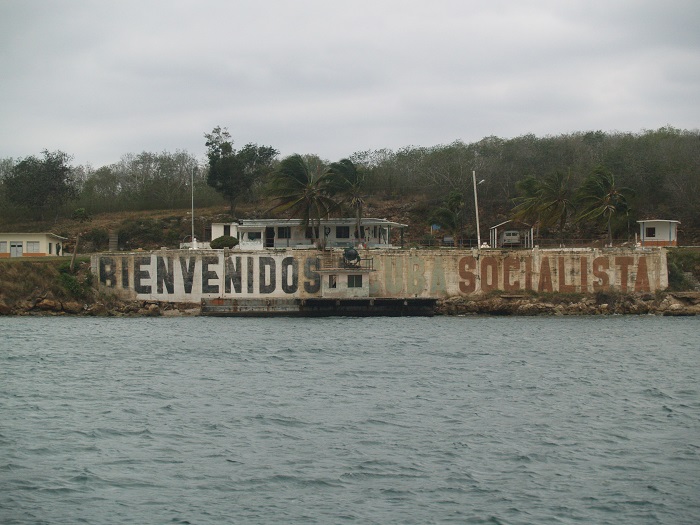 Images of Fidel, Raoul and Che are everywhere. Interestingly, the images of Fidel displayed make him look like the kindly grandfather now and not the fire-breathing revolutionary of the past.
Images of Fidel, Raoul and Che are everywhere. Interestingly, the images of Fidel displayed make him look like the kindly grandfather now and not the fire-breathing revolutionary of the past.
The day after our arrival we enjoyed a nice, if overpriced lunch at a government run restaurant in a magnificent “Moroccan” style mansion. What an amazing building and in near perfect condition. The interior was totally over the top.
The interior was totally over the top. 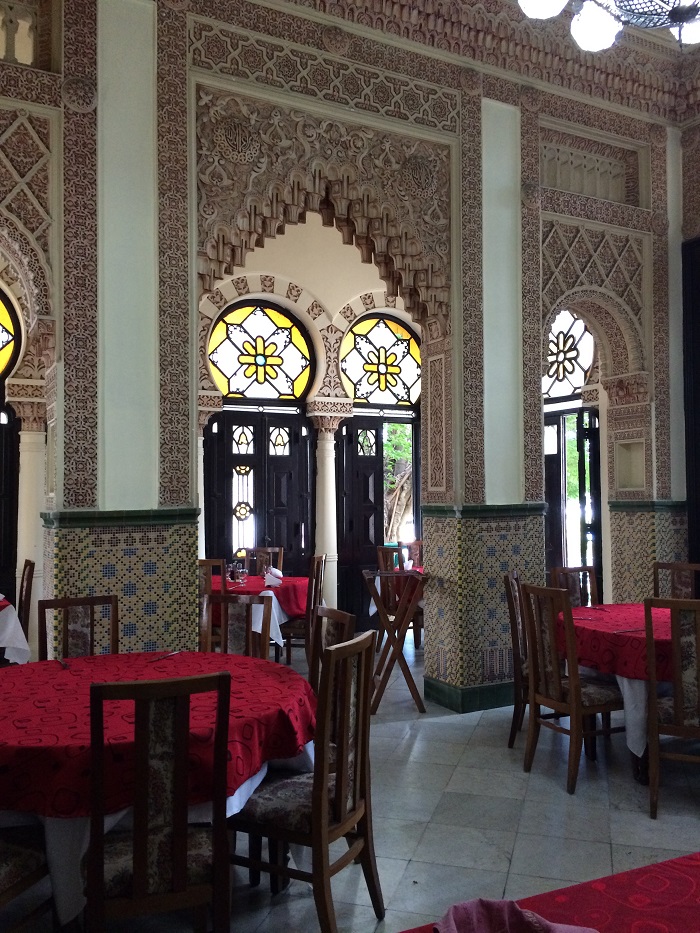
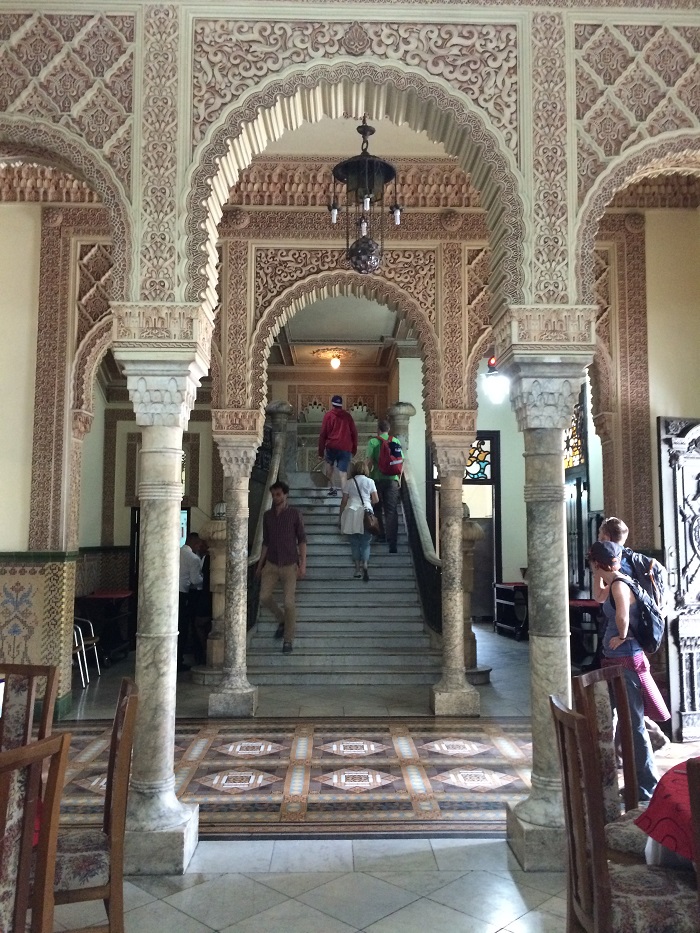 Our son Rob loves remodeling so perhaps he can take a cue from this and do some carvings in his dining room. How about it Rob? How would this look with Kandice’s Home Goods décor?
Our son Rob loves remodeling so perhaps he can take a cue from this and do some carvings in his dining room. How about it Rob? How would this look with Kandice’s Home Goods décor?
There is a rooftop bar with an amazing view. Perhaps Brenda and I will go there tonight to watch the sunset. There’s quite a view from the bar. 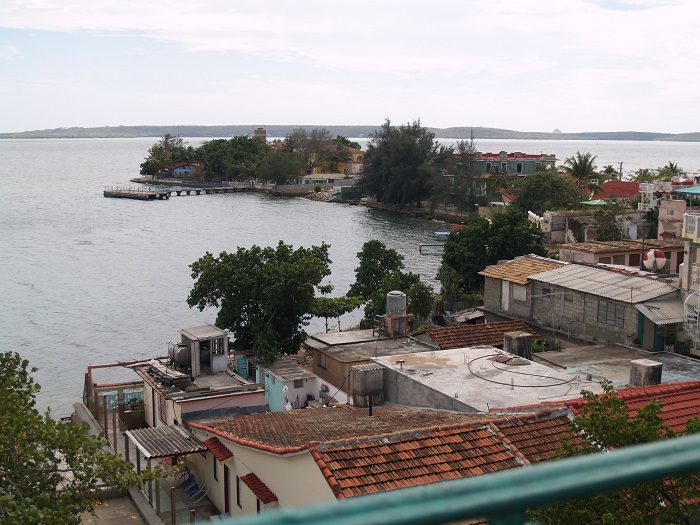 I wonder how we’ll do coming down the spiral staircase after a few mojitos?
I wonder how we’ll do coming down the spiral staircase after a few mojitos?
Even though this is a major city, clogged with cars, trucks and motorcycles spewing exhaust as they zoom by, it also boasts a healthy population of pedal cabs and horse drawn carts. The contrast of the old and (sort of) new is amazing and yet It seems to fit here. And with everyone employed by the State, there are plenty of workers to keep the streets clean and bushes neatly trimmed. While in many ways things are run down but they are very neat and tidy way that only “full employment” would allow.
Unlike Santiago de Cuba, with perhaps less than ten visiting boats in the harbor, Cienfuegos has dozens of boats at anchor and there are even four boats here from the U.S. the first cruisers that we have seen from The States, since clearing into Cuba in early March.
Yesterday, I decided that we needed some bread so I set off early to find a bakery. As the only bakery nearby was in downtown Cienfuegos, a 30 minute walk, I opted to take a “Peso bus” with the locals. As I have mentioned, there are two types of cash here, the CUC “cook” that trade at about $.85 U.S. and the “Local Peso” that trade at 25 to one CUC. Anyway, the bus, used by Cubans, costs one Peso, about five cents. As you can imagine, these busses are very popular and wow, was it packed with morning commuters. Forget about finding a seat. It was standing room only, at best.
After asking several locals, Spanish/English phrase book in hand, I found the bakery. There was a long line outside of locals waiting to purchase bread and after about a half hour in line, the bread came out of the oven and in we all went to make our purchases. Most shops in Cuba do not provide any sort of shopping bag so you have to bring your own. Often, there is someone standing outside the shop selling plastic bags for one “local” Peso. My purchase, two foot long loaves of bread, 8 local pesos each, less than a dollar total.
Any sort of “necessity” for the locals is heavily subsidized and very cheap. However, that’s not the case with fuel that is sold for a set rate of $1 CUC/liter, about $5 a gallon.
It’s always interesting to see lines form outside of shops waiting to make their purchases when they find that something they need will soon be for sale. There are no fully stocked stores so any shopping trip is more like a scavenger hunt to many shops, looking for what you need. As an example, yesterday Brenda and I purchased butter and cheese. The “deli” counter had only one type of cheese, sold in one kilo chunks, sort of salty mozzarella, and small half pound blocks of butter in a silver wrapper. Oddly, we had to pay for the butter at the checkout and then show the receipt to the person in the deli before he would give it to us. No so for the cheese which was weighed, priced and then given to us to pay for at the front register. Needless to say, the process was very confusing for us and caused quite a backup at the register as we tried to understand the procedure. I think that it had something to do with butter being rationed however everyone was good natured as we muddled our way through the process.
In the center of Cienfuegos, is a lovely square surrounded by magnificent buildings and a magnificent theater or opera house. The buildings are in beautiful condition.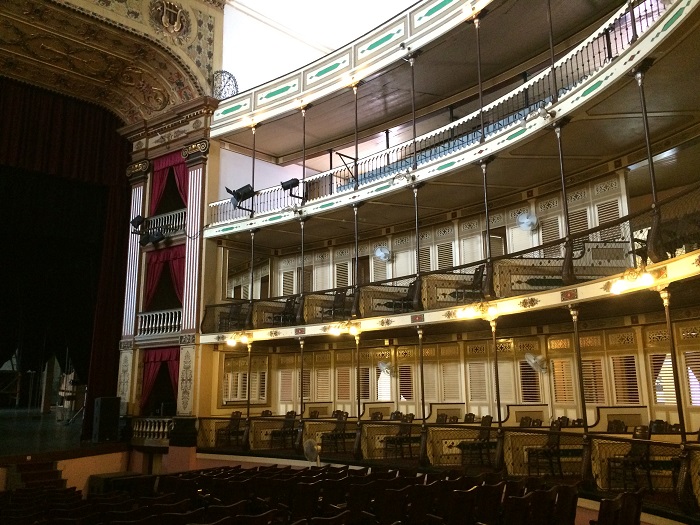 What a ceiling decorated to the max.
What a ceiling decorated to the max.  Some of the buildings on the square had cafes out front. We stopped and sat for a while in one while listening to a wonderful group of musicians. They performed beautifully. What a treat.
Some of the buildings on the square had cafes out front. We stopped and sat for a while in one while listening to a wonderful group of musicians. They performed beautifully. What a treat. 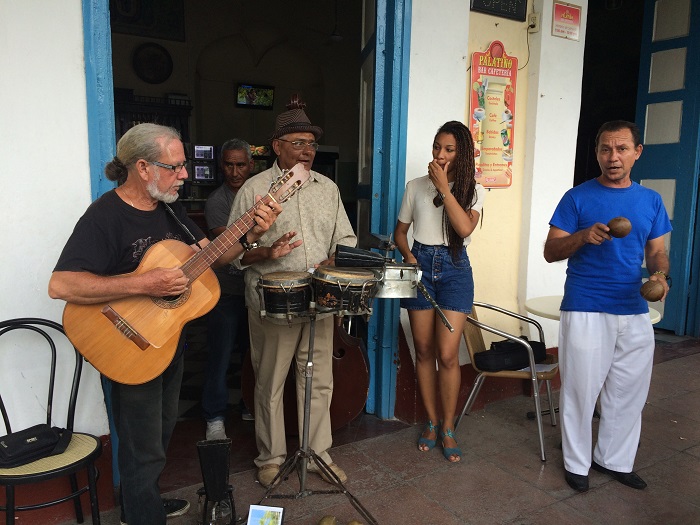 Love the spiral stairs in this tower.
Love the spiral stairs in this tower.
 We went into the theater to take a look around. It was built in the 1800s and is in near perfect condition. It was a throwback to an earlier time of great wealth in Cuba. We learned that there is a play being put on in the theater on Sunday so if we aren’t totally “concerted out” by then, perhaps we’ll give it a try.
We went into the theater to take a look around. It was built in the 1800s and is in near perfect condition. It was a throwback to an earlier time of great wealth in Cuba. We learned that there is a play being put on in the theater on Sunday so if we aren’t totally “concerted out” by then, perhaps we’ll give it a try.
When we return home to CT I hope to give a talk at the Essex Yacht Club and couldn’t resist getting a shot of myself holding the club colors. I’ll bet it’s been a long time since the EYC colors have been flown in Cuba and this shot “proves it”, I guess. Of course, there was a great selection of beautifully maintained classic taxis to feast your eyes on here like everywhere in Cuba.
Of course, there was a great selection of beautifully maintained classic taxis to feast your eyes on here like everywhere in Cuba. 
 How about this old Ford? As is often the case, not all together original. Love the roof racks.
How about this old Ford? As is often the case, not all together original. Love the roof racks. 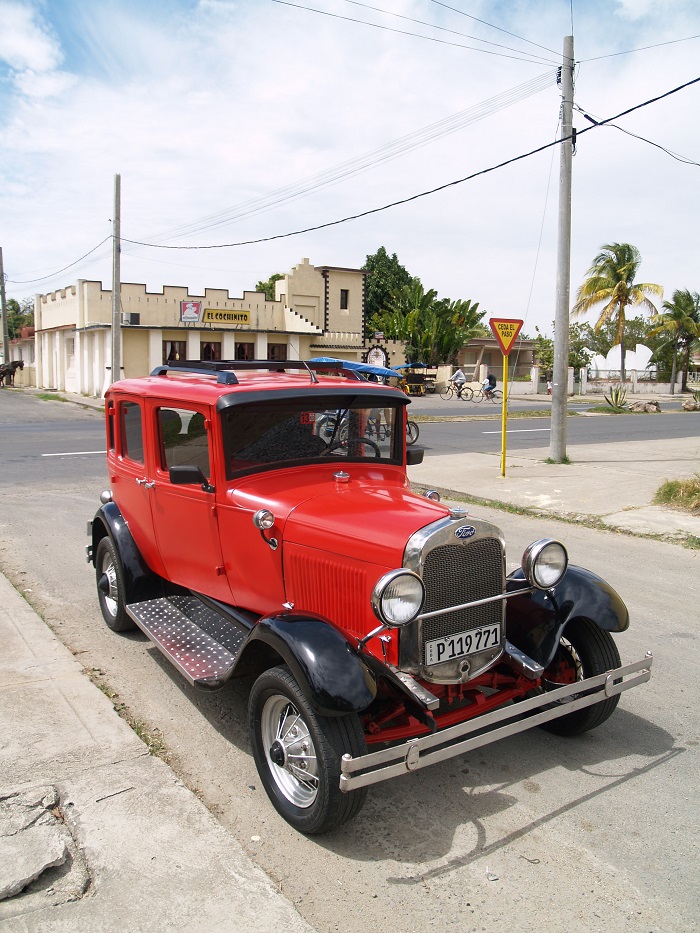 It must take an amazing amount of dedication to keep them looking like this after decades of hard daily work. Of course, many don’t look like this at all but many re just amazing.
It must take an amazing amount of dedication to keep them looking like this after decades of hard daily work. Of course, many don’t look like this at all but many re just amazing.
In any event, with the Stones concert in Havana on Friday, our pending bus trip and who knows what else that may lie ahead as we make our way through Cuba I guess it’s safe to say that “Rolling Stones gather no moss” is a phrase that certainly applies to Pandora and her crew this winter.
Perhaps even more amazing, Brenda, the “vagabond” and risk taker? Who knew? I guess more contact with wayward sailors like Lars will fully corrupt her. Before you know it, she’ll be puffing away on a cigar and having shots of Cuban rum. Now, that’s an image…
And speaking of the “for the moment, free spirit” Brenda, you should check out her blog at www.argoknot.com to see if I speak the truth.

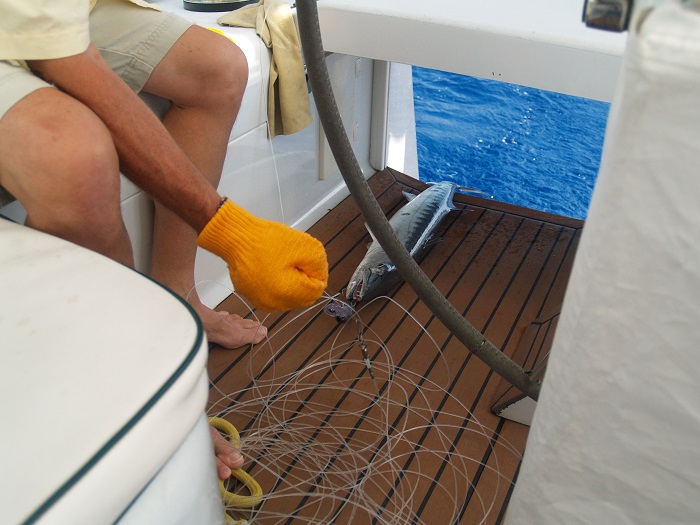
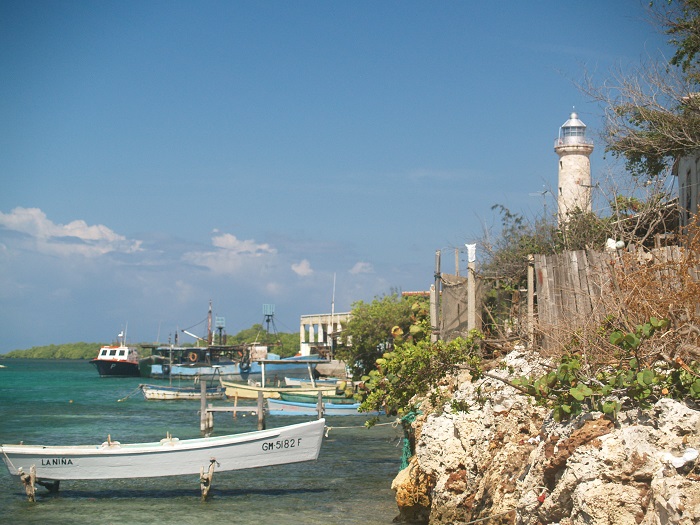 I also saw a newborn goat with mother nearby.
I also saw a newborn goat with mother nearby.  I had hoped that they would be willing to just sign us out and that we could be on my way. No, no, no, that wasn’t going to happen. They must visit our boat personally to sign us out.
I had hoped that they would be willing to just sign us out and that we could be on my way. No, no, no, that wasn’t going to happen. They must visit our boat personally to sign us out.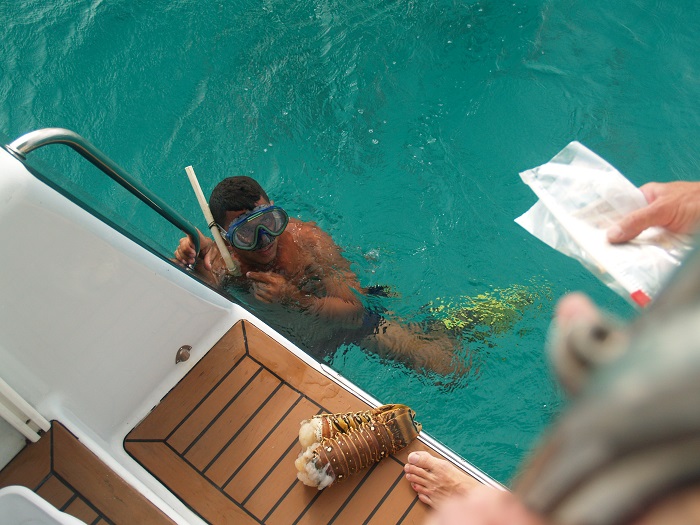 After a bit of haggling we put some money in a zip lock bag and off he went.
After a bit of haggling we put some money in a zip lock bag and off he went. He shares the island with a multitude of critters including a health population of iguanas as well as thousands of hermit crabs that I guess he feeds as they all gather around his kitchen window to nibble on scraps he sends their way.
He shares the island with a multitude of critters including a health population of iguanas as well as thousands of hermit crabs that I guess he feeds as they all gather around his kitchen window to nibble on scraps he sends their way.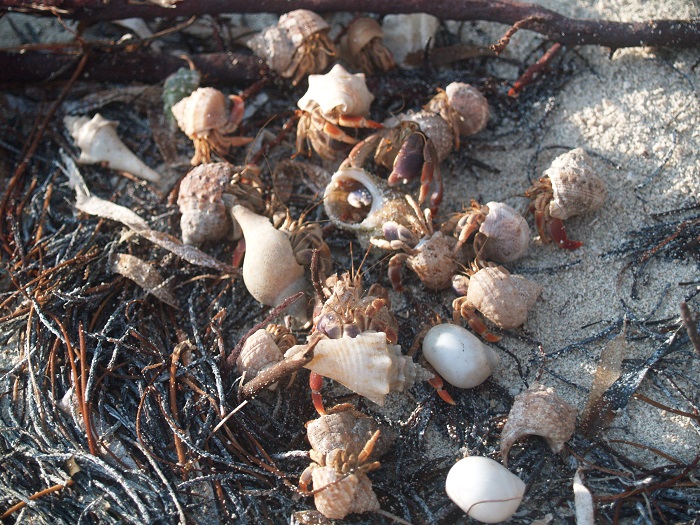 And, of course, Iguanas.
And, of course, Iguanas. 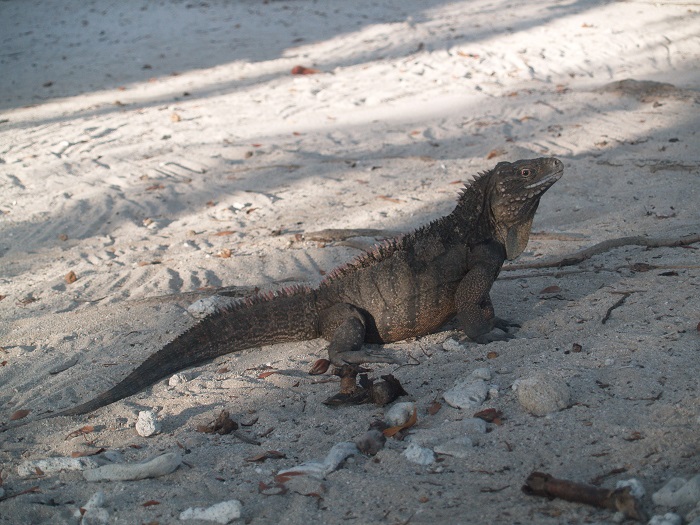 A nice view from the beach of Pandora well beyond “no-see-um-zone”.
A nice view from the beach of Pandora well beyond “no-see-um-zone”.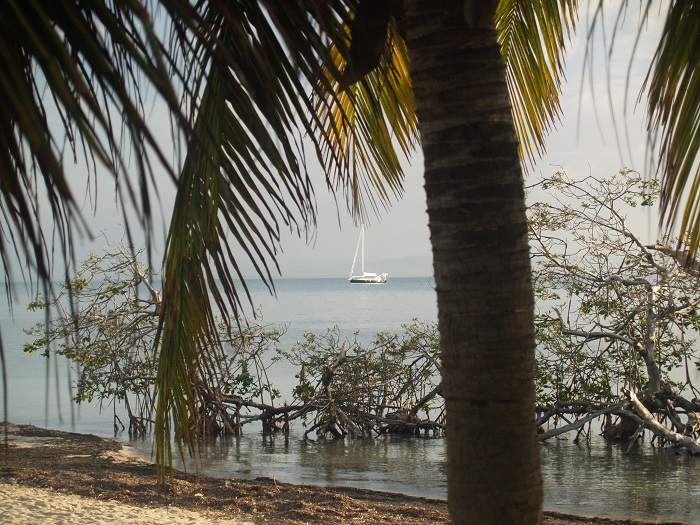 He seemed like a nice guy although his chain smoking and, shall we say, “lack of dental hygiene” made us decide not to order any food. Good call.
He seemed like a nice guy although his chain smoking and, shall we say, “lack of dental hygiene” made us decide not to order any food. Good call. However their is beauty in simplicity as this local swimming hole and park with specatular mountains in the distance illustrates.
However their is beauty in simplicity as this local swimming hole and park with specatular mountains in the distance illustrates.  There are livestock everywhere including goats, turkeys (I guess this is a turkey) and a constant background sounds of cocks crowing, day and night.
There are livestock everywhere including goats, turkeys (I guess this is a turkey) and a constant background sounds of cocks crowing, day and night.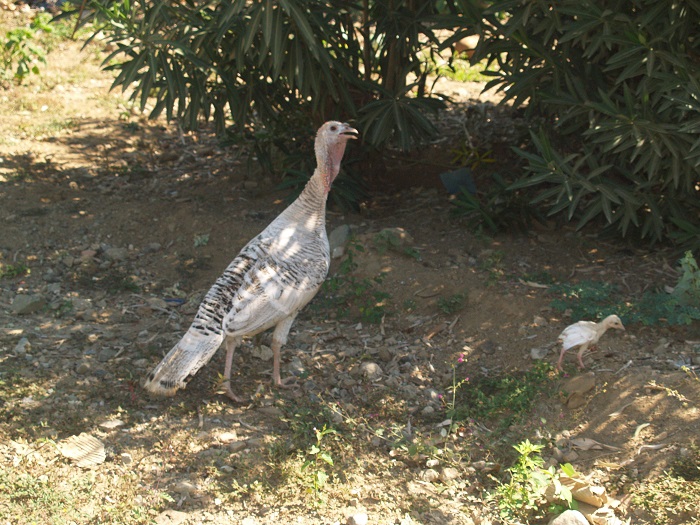 Village homes are simple and neatly kept and usually have a garden nearby. This family is growing bananas, sugarcane and simple green vegetables.
Village homes are simple and neatly kept and usually have a garden nearby. This family is growing bananas, sugarcane and simple green vegetables.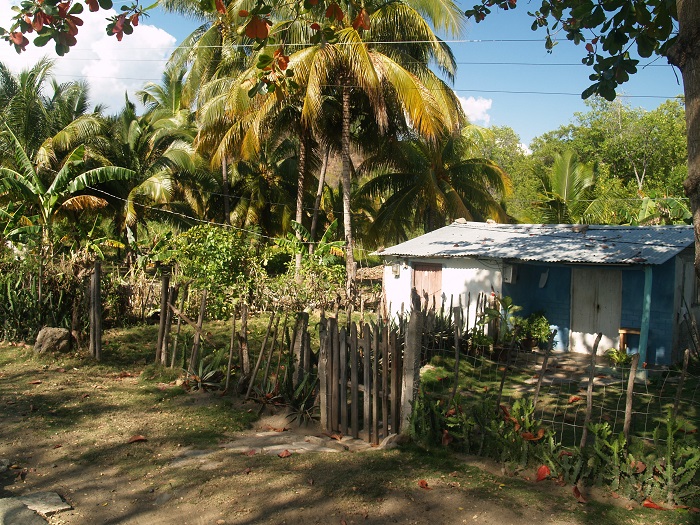 And, there is perhaps no greater contrast to Pandora than this simple “boat”, an inner tube employed by a local fisherman. He paddled around the lagoon all day casting a net to catch fish less than two inches long and carefully picked his catch from the net and put in the “live well” milk crate floating next to him. I don’t know if that was his ultimate catch or if he used them as bait for larger quarry.
And, there is perhaps no greater contrast to Pandora than this simple “boat”, an inner tube employed by a local fisherman. He paddled around the lagoon all day casting a net to catch fish less than two inches long and carefully picked his catch from the net and put in the “live well” milk crate floating next to him. I don’t know if that was his ultimate catch or if he used them as bait for larger quarry.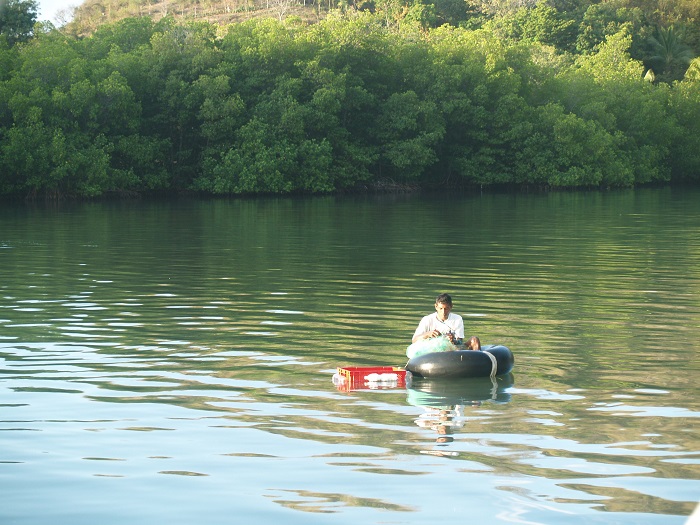 In Cuba there are two worlds. That of the locals and the other occupied by tourists who stay at government run resorts that are simple by our standards. These cater to foreigners, mainly from Canada and Europe who visit Cuba, often for the entire winter season. The government even has a separate currency, the CUC, pronounced “cook”, for tourists, valued at about $.85 to the US dollar. The locals trade in Pesos valued at 25 to the CUC. The Peso is used at the markets and for goods sold to locals at government shops.
In Cuba there are two worlds. That of the locals and the other occupied by tourists who stay at government run resorts that are simple by our standards. These cater to foreigners, mainly from Canada and Europe who visit Cuba, often for the entire winter season. The government even has a separate currency, the CUC, pronounced “cook”, for tourists, valued at about $.85 to the US dollar. The locals trade in Pesos valued at 25 to the CUC. The Peso is used at the markets and for goods sold to locals at government shops. The rooms, and there were only about 20, were located around a center courtyard with a pool. It was a lovely spot. We paid a flat rate of $12 CUC each for lunch and for that flat fee we were able to order anything and in any quantity from the menu. Brenda had grilled chicken with a sweet relish and I had grilled fish along with a number of other side dishes.
The rooms, and there were only about 20, were located around a center courtyard with a pool. It was a lovely spot. We paid a flat rate of $12 CUC each for lunch and for that flat fee we were able to order anything and in any quantity from the menu. Brenda had grilled chicken with a sweet relish and I had grilled fish along with a number of other side dishes.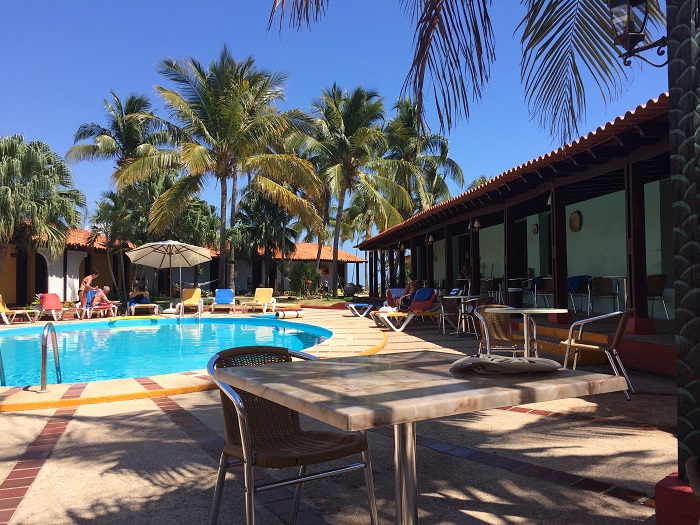 Lunch was actually an add-on for us as our primary reason for visiting the hotel was to access the Internet at their single public terminal. At most all government facilities you can purchase time on their computers for $2 CUC per hour and the speeds are pretty good. I understand that this service runs through an under-sea cable that was strung from Venezuela a few years ago.
Lunch was actually an add-on for us as our primary reason for visiting the hotel was to access the Internet at their single public terminal. At most all government facilities you can purchase time on their computers for $2 CUC per hour and the speeds are pretty good. I understand that this service runs through an under-sea cable that was strung from Venezuela a few years ago. It was interesting to hear what sort of information he was looking for, beyond the obvious about our last port of call and where we were going next. Along with checking our passports, he needed to know the height of our mast, depth of our keel, beam and such esoteric information such as what the fuel capacity of our dink was and how much water we had on board. And, all of this information was carefully recorded in a well-thumbed notebook while the fisherman patiently waited behind Pandora.
It was interesting to hear what sort of information he was looking for, beyond the obvious about our last port of call and where we were going next. Along with checking our passports, he needed to know the height of our mast, depth of our keel, beam and such esoteric information such as what the fuel capacity of our dink was and how much water we had on board. And, all of this information was carefully recorded in a well-thumbed notebook while the fisherman patiently waited behind Pandora.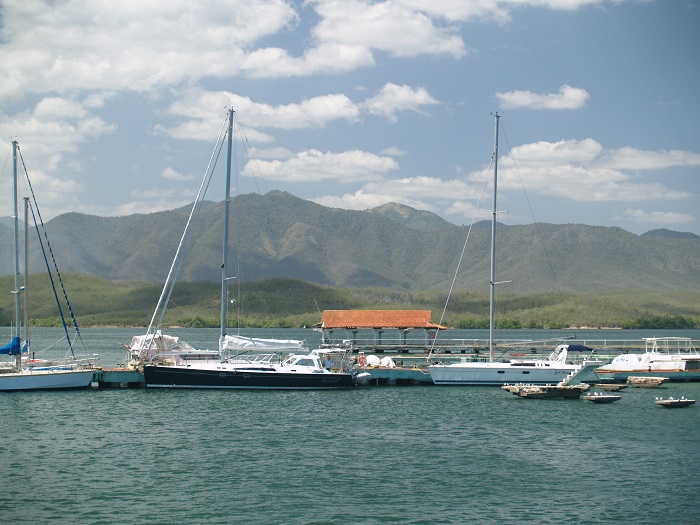 Just before we left Santiago a number of rowing shells from the local boat club rowed by. I have to say that I wasn´t epecting to see such a sight in a comunist country. Fedel, row harder. You are out of sync…
Just before we left Santiago a number of rowing shells from the local boat club rowed by. I have to say that I wasn´t epecting to see such a sight in a comunist country. Fedel, row harder. You are out of sync… The sunset to the west each evening was spectacular. In the afternoons it blows like stink but the wind dies at sunset making for a beautiful, if hot, evening. We were able to run the AC in the front cabin but the electrical connection wasn´t strong enough to support the AC in the main salon or the battery charger. Glad we have the solar panels.
The sunset to the west each evening was spectacular. In the afternoons it blows like stink but the wind dies at sunset making for a beautiful, if hot, evening. We were able to run the AC in the front cabin but the electrical connection wasn´t strong enough to support the AC in the main salon or the battery charger. Glad we have the solar panels. 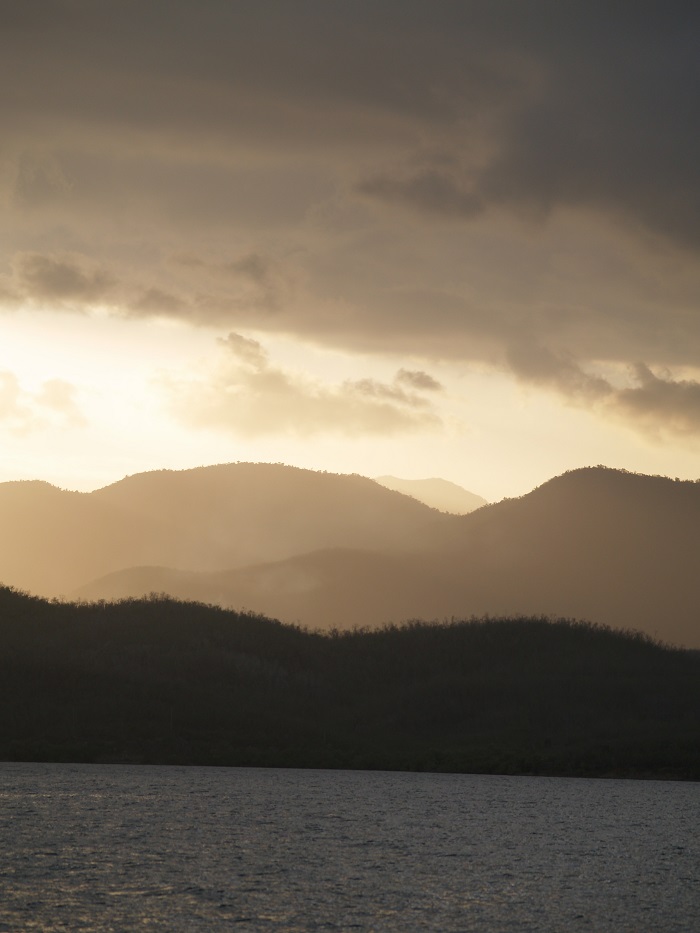 A few days ago I took the ferry from the marina to downtown Santiago. You want third world, this was third world. Show me the life preservers. Ha!
A few days ago I took the ferry from the marina to downtown Santiago. You want third world, this was third world. Show me the life preservers. Ha!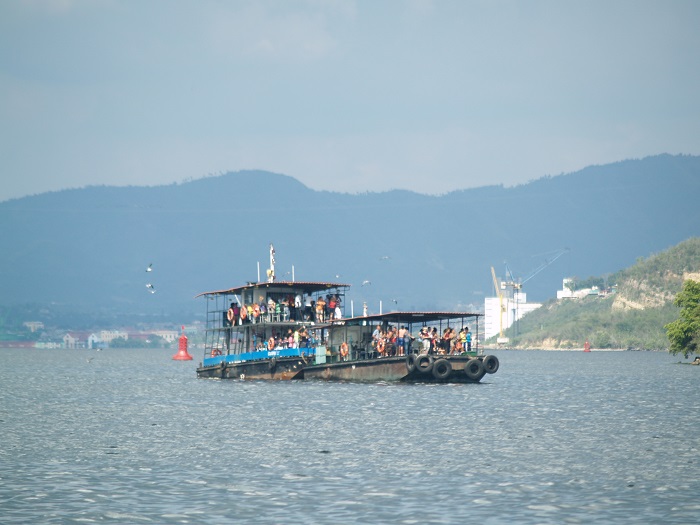 What a view from the boat as we approached the city from the water.
What a view from the boat as we approached the city from the water.  When we came into the harbor at Santiago to anchor in the quarantine area a week ago Brenda was at the helm as is customary for us as I handled the anchor. The woman that checked us in decided that Brenda, being at the helm, was the ¨Capitan¨ and put her as such on the paperwork. This means that each time we clear in or out of a port Brenda is “El Capitan” from now on and has to sign any papers. We both got quite a kick out of that. Well, mostly me and the lady that checked us in, of course.
When we came into the harbor at Santiago to anchor in the quarantine area a week ago Brenda was at the helm as is customary for us as I handled the anchor. The woman that checked us in decided that Brenda, being at the helm, was the ¨Capitan¨ and put her as such on the paperwork. This means that each time we clear in or out of a port Brenda is “El Capitan” from now on and has to sign any papers. We both got quite a kick out of that. Well, mostly me and the lady that checked us in, of course. A bit later they swam out to us, I expect with the hope of some sort of handout.
A bit later they swam out to us, I expect with the hope of some sort of handout. 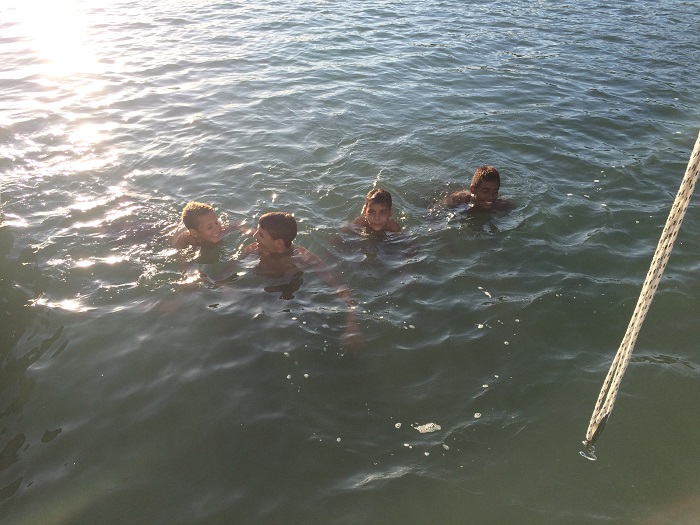 I was tempted but didn’t want them with us for the duration of our visit. Chivirico is a tiny rural fishing village, much different than Santiago with all its noise and activity. The locals make their living fishing out of little boats and in inner tubes that they float around with while casting lines. The boats that they take out into the ocean are impossibly small with tiny inboard engines.
I was tempted but didn’t want them with us for the duration of our visit. Chivirico is a tiny rural fishing village, much different than Santiago with all its noise and activity. The locals make their living fishing out of little boats and in inner tubes that they float around with while casting lines. The boats that they take out into the ocean are impossibly small with tiny inboard engines.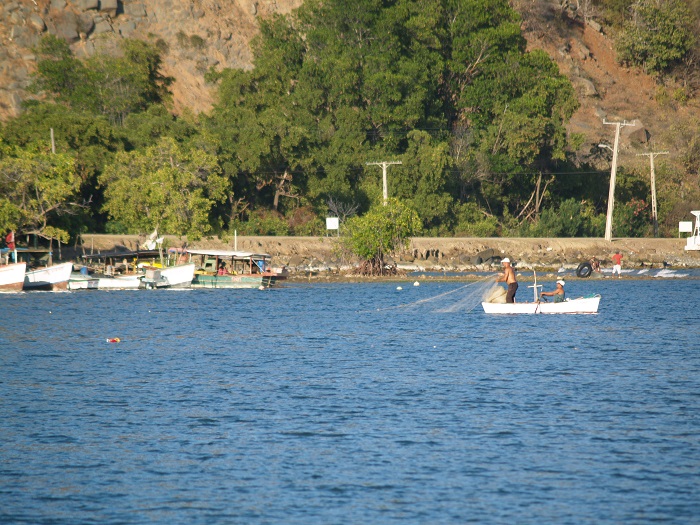 It was interesting to see the smaller fish jumping out of the water as larger ones below cornered them against the net. They sparkled as they jumped out of the water in the late afternoon light. It was quite a sight.
It was interesting to see the smaller fish jumping out of the water as larger ones below cornered them against the net. They sparkled as they jumped out of the water in the late afternoon light. It was quite a sight.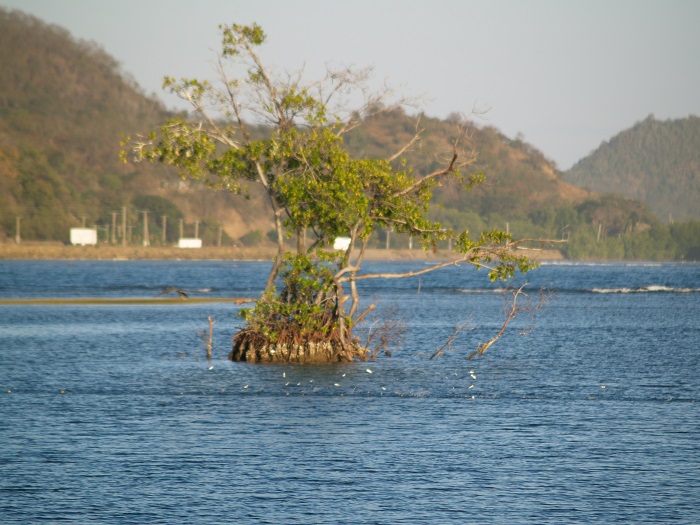 There are some very quaint buildings along the mangrove shoreline and even two thatched huts at a sort of park were the children were swimming.
There are some very quaint buildings along the mangrove shoreline and even two thatched huts at a sort of park were the children were swimming. 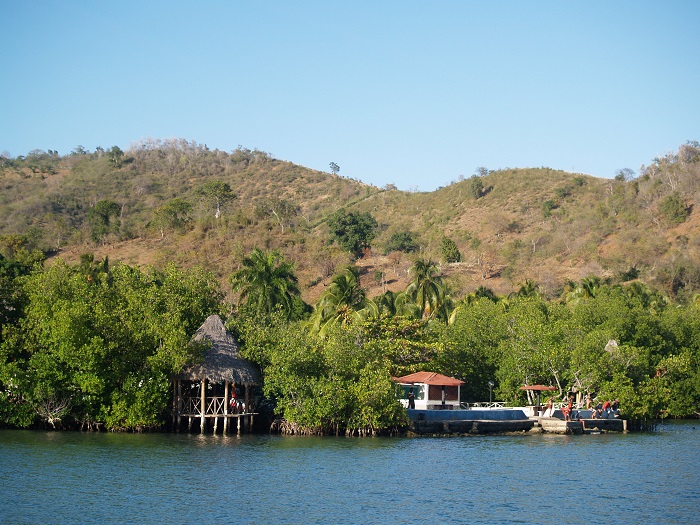 Sunset, and I love sunsets in blog posts as you know, and this one was beautiful. I´d like to see Brenda weave this as a tapestry. It was a magical moment.
Sunset, and I love sunsets in blog posts as you know, and this one was beautiful. I´d like to see Brenda weave this as a tapestry. It was a magical moment.
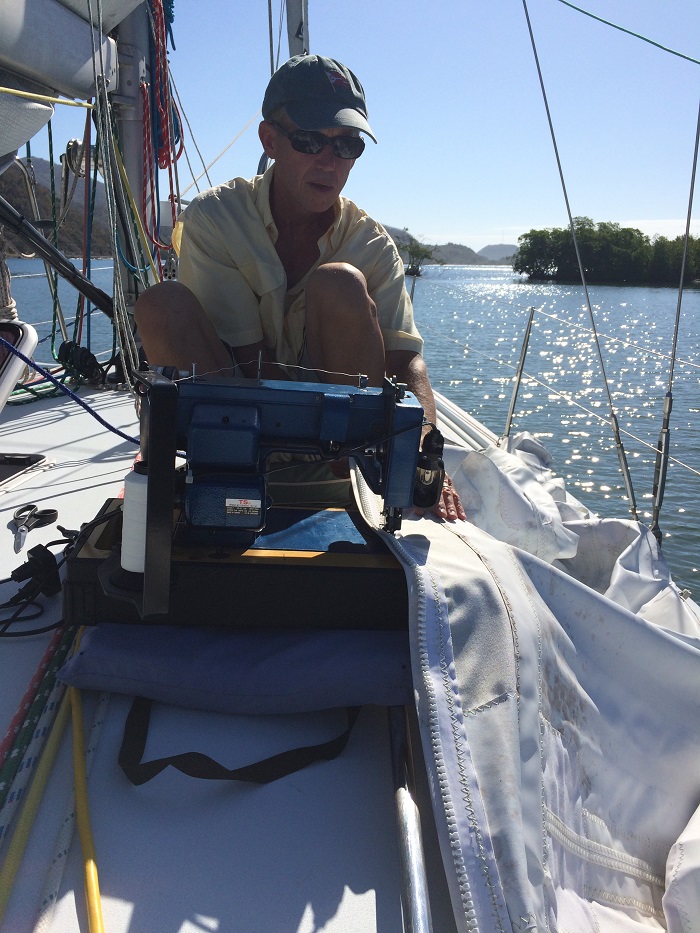 It was a good example of the cruising life of “boat repair in exotic places”. Did I mention that I had a sewing machine on board? Good thing as it’s the second time I have used it since leaving CT last October.
It was a good example of the cruising life of “boat repair in exotic places”. Did I mention that I had a sewing machine on board? Good thing as it’s the second time I have used it since leaving CT last October.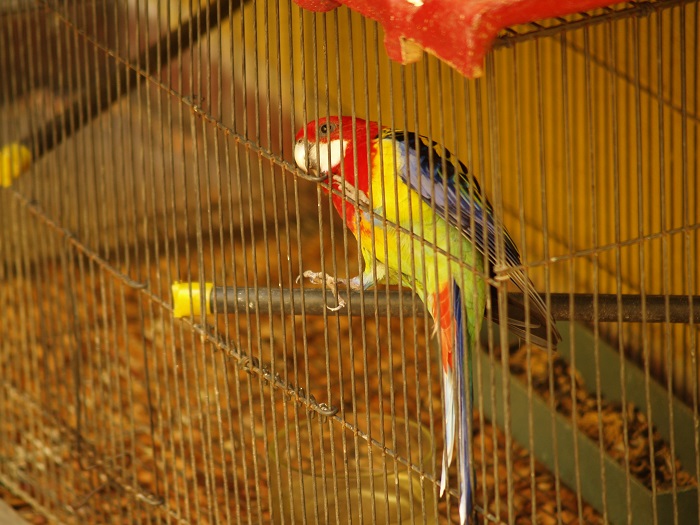
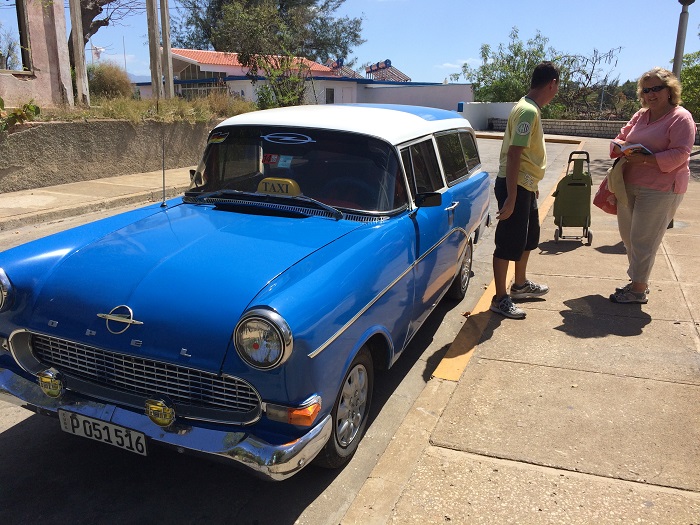 Even the interior was perfect, if a bit off of the original specs.
Even the interior was perfect, if a bit off of the original specs.  There are thousands of old cars, trucks and motorcycles spewing choking exhaust on impossibly narrow colonial streets so clogged with traffic that crossing is a life threatening experience.
There are thousands of old cars, trucks and motorcycles spewing choking exhaust on impossibly narrow colonial streets so clogged with traffic that crossing is a life threatening experience.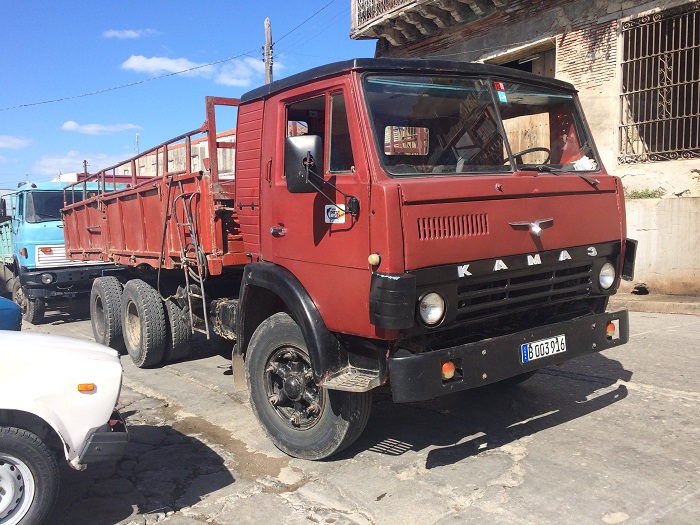
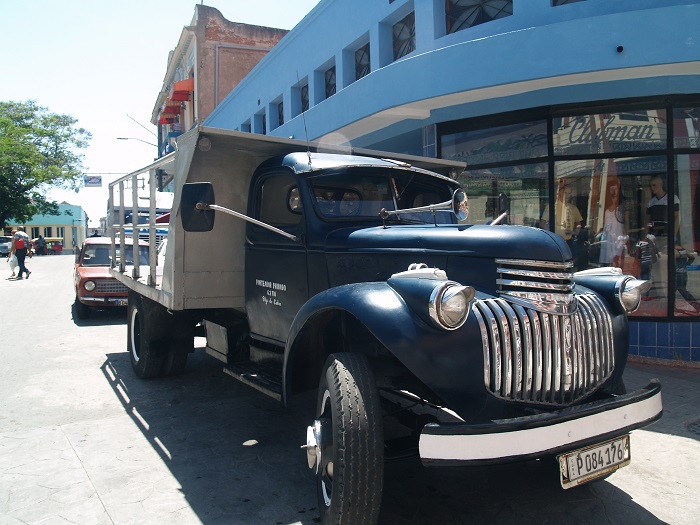
 Not all of the cars were in as nice shape as this vintage VW.
Not all of the cars were in as nice shape as this vintage VW.  For sure, plenty will be changing in Cuba as they open up to the world. Perhaps there is no better illustration of the challenges that this country faces than the long lines of young people waiting outside of the cell phone store waiting to enter for service. And,as in the U.S. , it seems like nearly everyone is busy huddling over their phones, perhaps, like us, trying to use the horrible wifi in public squares. For sure, wifi is not great as it took me an hour yesterday and all of the time on my prepaid wificard to get just a simple post with one photo to publish. Today I am in a cafe using their computers so it´s going much better, so far…
For sure, plenty will be changing in Cuba as they open up to the world. Perhaps there is no better illustration of the challenges that this country faces than the long lines of young people waiting outside of the cell phone store waiting to enter for service. And,as in the U.S. , it seems like nearly everyone is busy huddling over their phones, perhaps, like us, trying to use the horrible wifi in public squares. For sure, wifi is not great as it took me an hour yesterday and all of the time on my prepaid wificard to get just a simple post with one photo to publish. Today I am in a cafe using their computers so it´s going much better, so far…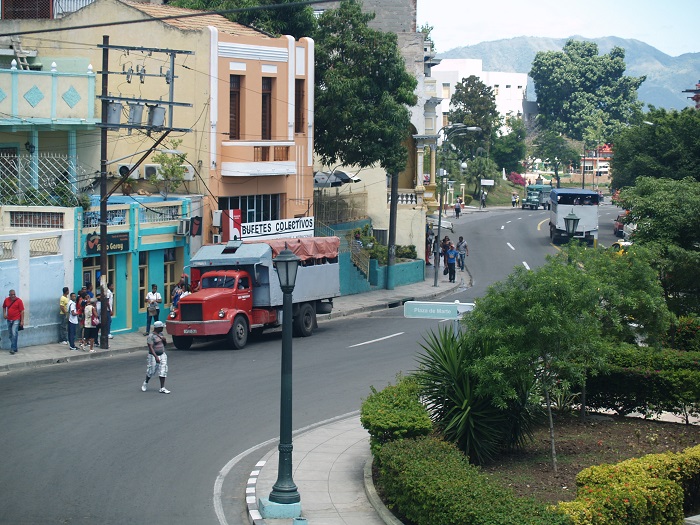 Surrounding the public squares are fabulous buildings, hundreds of years old and in perfect condition, at least from the outside and yet only a few blocks away homes in a terrible state of disrepair.
Surrounding the public squares are fabulous buildings, hundreds of years old and in perfect condition, at least from the outside and yet only a few blocks away homes in a terrible state of disrepair. 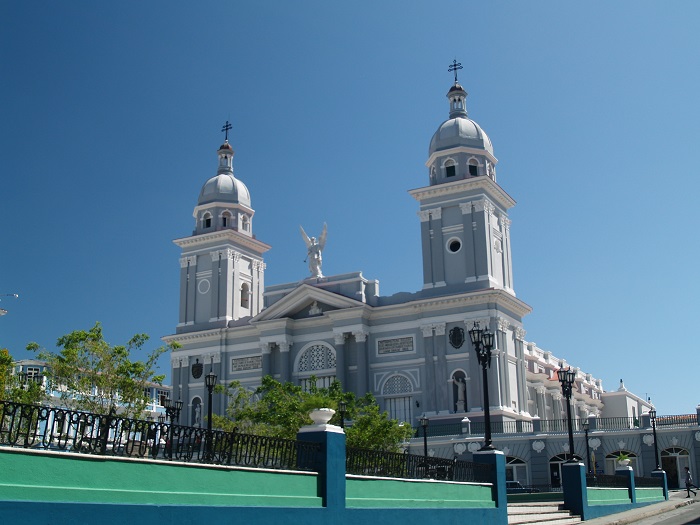 Yesterday we had lunch at a Paladar, a family run restaurant on a rooftop overlooking the harbor and countless homes on the hillside. Wonderful food and reasonbly priced. Great Mojito too.
Yesterday we had lunch at a Paladar, a family run restaurant on a rooftop overlooking the harbor and countless homes on the hillside. Wonderful food and reasonbly priced. Great Mojito too.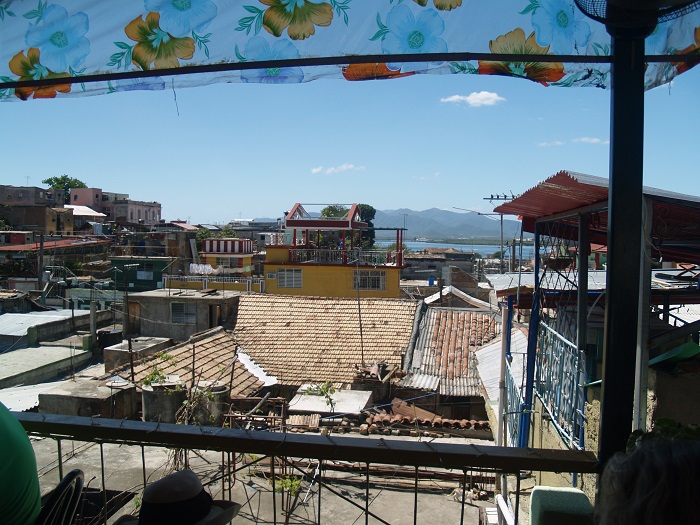 The nearby market had some interesting items for sale. I sure hope our lunch didn´t come from this stall.
The nearby market had some interesting items for sale. I sure hope our lunch didn´t come from this stall. 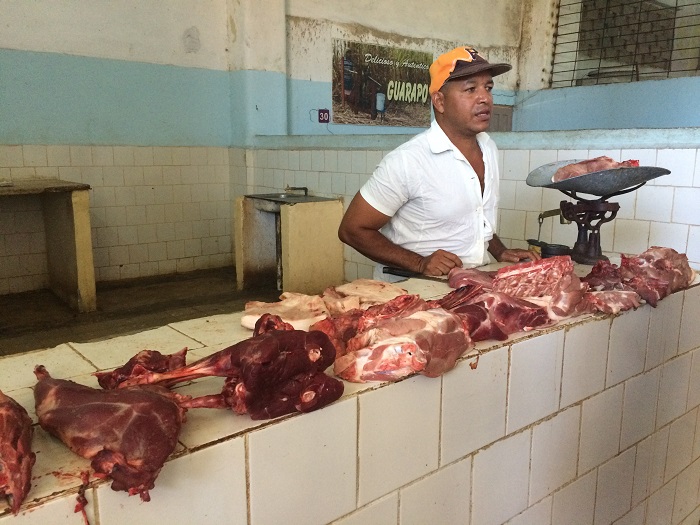 Perhaps this fruit stand is more our speed.
Perhaps this fruit stand is more our speed. 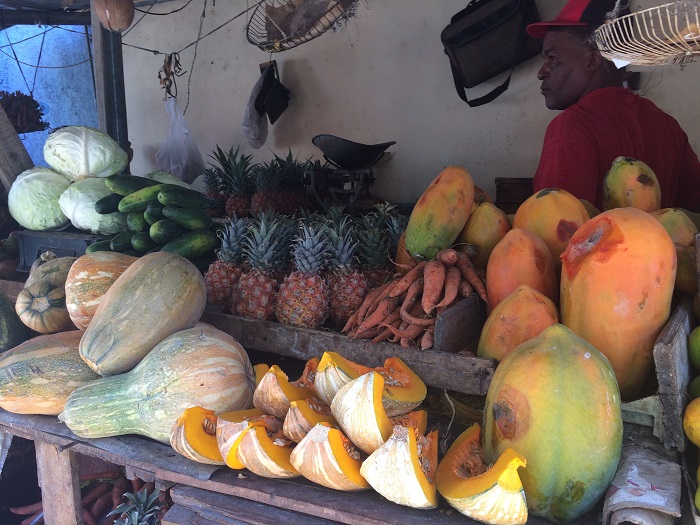 On a nearby rooftop, a dog that looked much like or Son Rob´s Bobi.
On a nearby rooftop, a dog that looked much like or Son Rob´s Bobi. 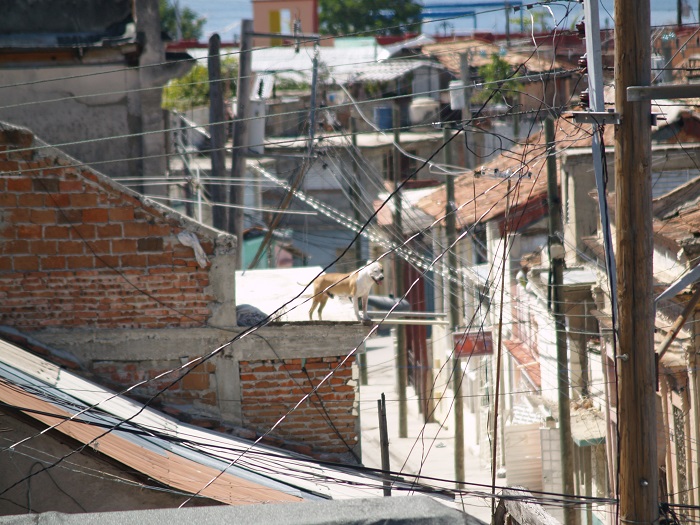 There are many busy and beautiful public spaces.
There are many busy and beautiful public spaces. 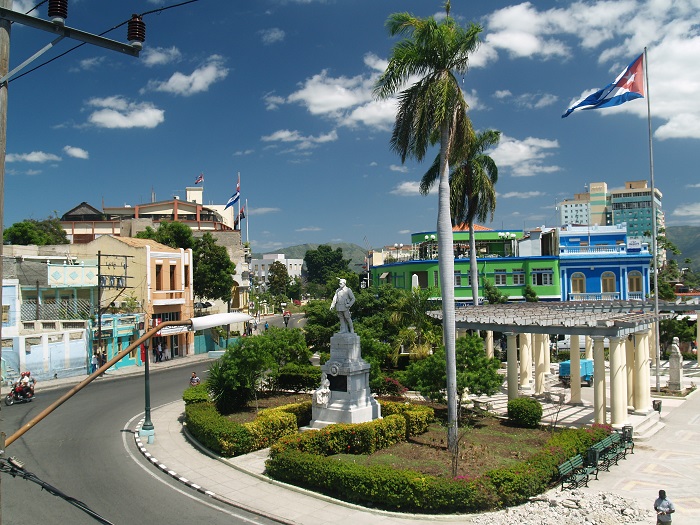
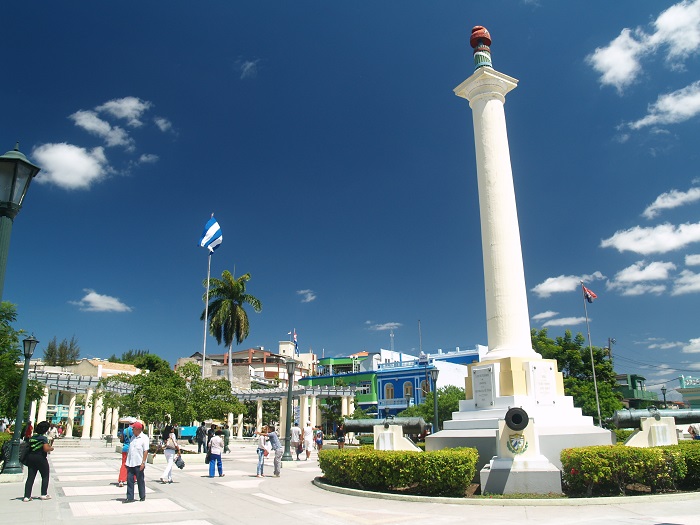 I still do a double take when I see the Cuban flag flying high.
I still do a double take when I see the Cuban flag flying high.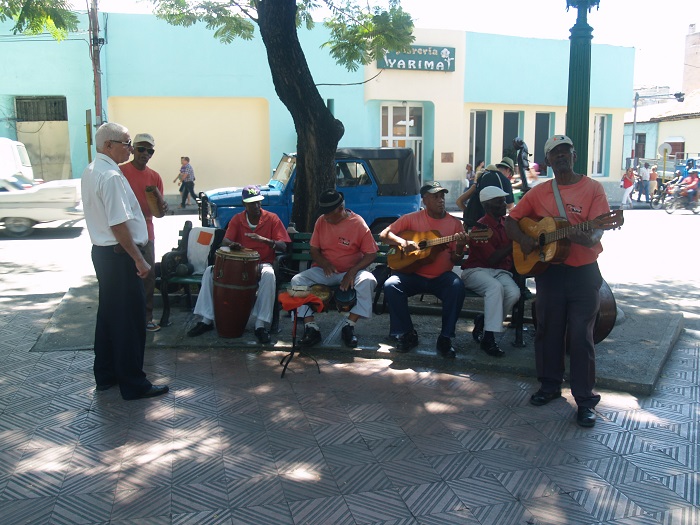 We stopped at a local hotel in the heat of the afternoon to cool off with fresh lemonaid. What a spot.
We stopped at a local hotel in the heat of the afternoon to cool off with fresh lemonaid. What a spot. 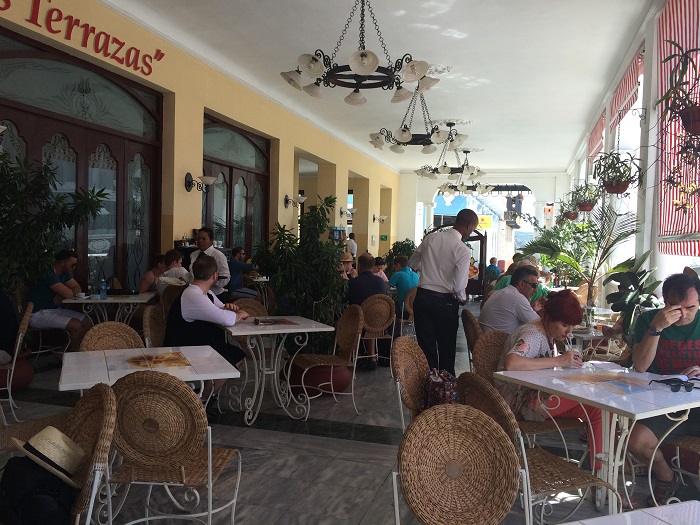 I could go on for hours and surely, with all the ¨fun¨ of finding a good spot to download all of this, perhaps I should quit while I am ahead.
I could go on for hours and surely, with all the ¨fun¨ of finding a good spot to download all of this, perhaps I should quit while I am ahead. As we approached the entrance of the harbor, and a dramatic one it is, we began hailing the Guarda Frontera on the VHF radio. We had been told to begin calling when we were about 15 miles out with the understanding that they probably wouldn’t respond until we were within a few miles as they only have hand held VHF radios.
As we approached the entrance of the harbor, and a dramatic one it is, we began hailing the Guarda Frontera on the VHF radio. We had been told to begin calling when we were about 15 miles out with the understanding that they probably wouldn’t respond until we were within a few miles as they only have hand held VHF radios. After that, we raised the anchor and headed back across the harbor and anchored as there was no room at the dock for us. We dropped the dink and took her ashore and us to meet with Immigration. That process took another hour and was followed by that official coming out to Pandora where he searched every nook and cranny for who knows what. After that, a beer together.
After that, we raised the anchor and headed back across the harbor and anchored as there was no room at the dock for us. We dropped the dink and took her ashore and us to meet with Immigration. That process took another hour and was followed by that official coming out to Pandora where he searched every nook and cranny for who knows what. After that, a beer together.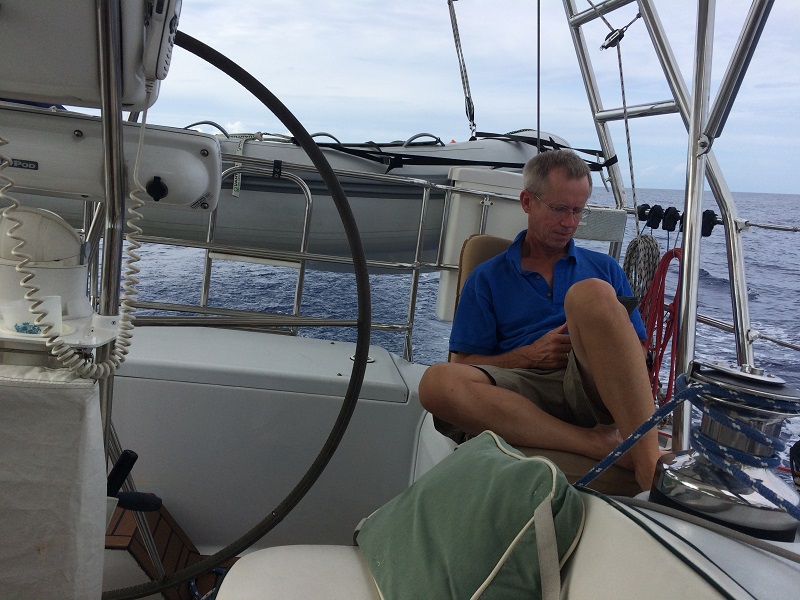 I will say that it’s pretty hot and a bit uncomfortable down below. Unfortunately, because of the risk of spray getting down below through open hatches, we have to keep the boat well buttoned up. We do have fans but with the engine located under the galley in the main cabin, there is extra heat down below so it’s pretty warm.
I will say that it’s pretty hot and a bit uncomfortable down below. Unfortunately, because of the risk of spray getting down below through open hatches, we have to keep the boat well buttoned up. We do have fans but with the engine located under the galley in the main cabin, there is extra heat down below so it’s pretty warm.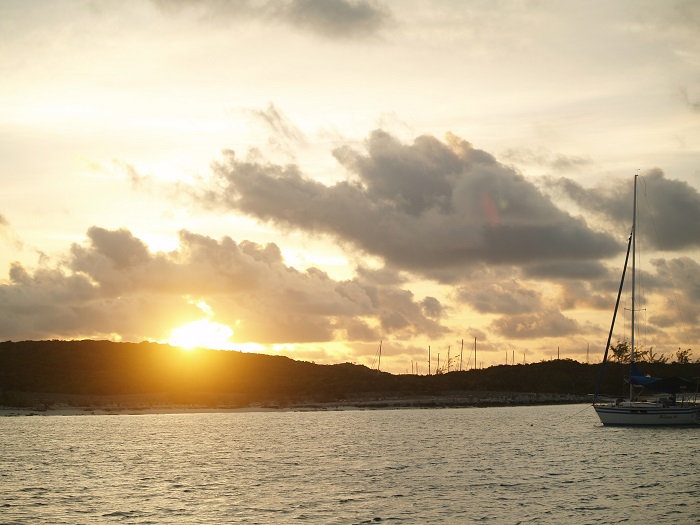 And, as the sun was higher in the sky, the clouds to the west took on a beautiful hue in the reflected sunrise.
And, as the sun was higher in the sky, the clouds to the west took on a beautiful hue in the reflected sunrise.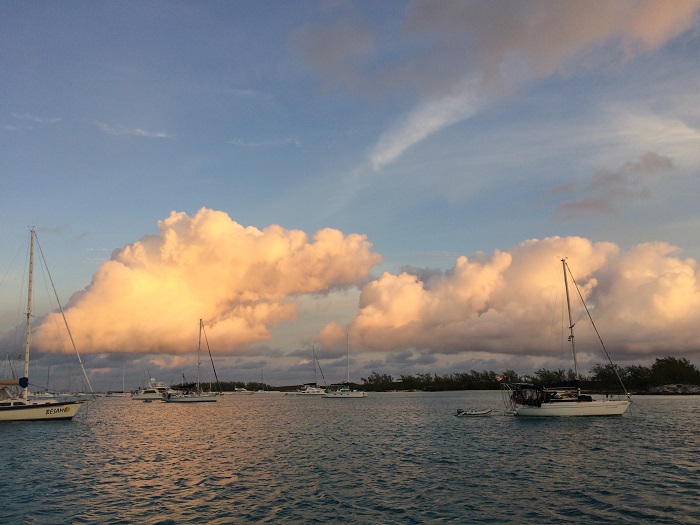 I coudn’t resist a panorama. If you click on the photo it will get bigger and hopefully more impressive. Notice Monument Hill in the center of the photo.
I coudn’t resist a panorama. If you click on the photo it will get bigger and hopefully more impressive. Notice Monument Hill in the center of the photo.  The other day I hiked up over the Monument Hill and took a photo of Pandora riding at anchor among the other boats.
The other day I hiked up over the Monument Hill and took a photo of Pandora riding at anchor among the other boats. 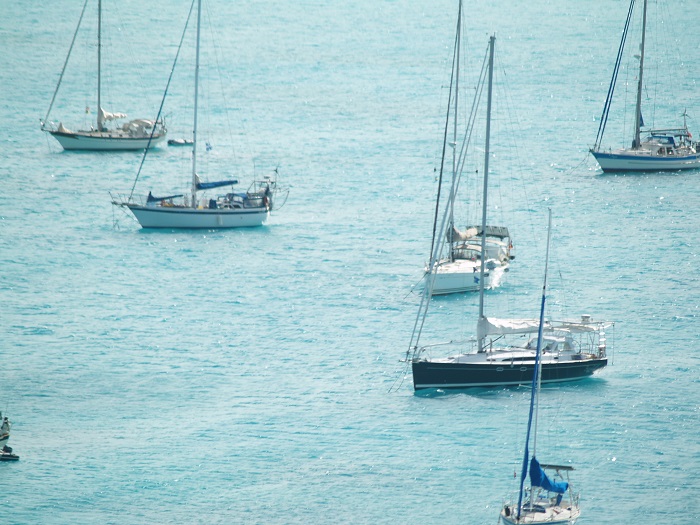 There are a LOT of boats here in the harbor. The view to the south shows just a portion of them.
There are a LOT of boats here in the harbor. The view to the south shows just a portion of them. 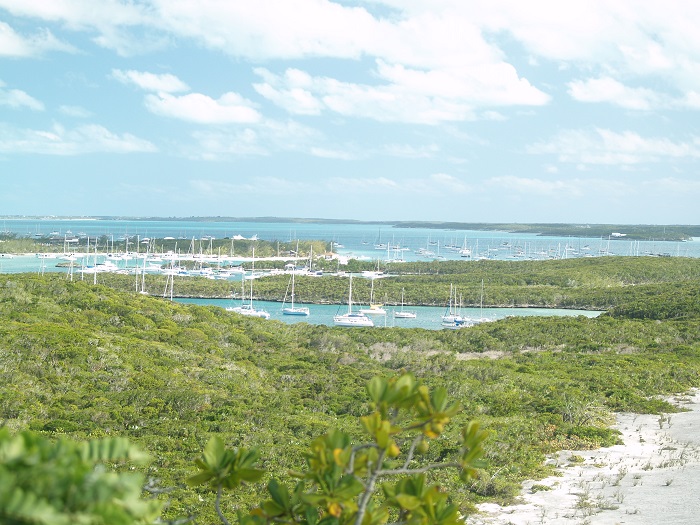 After enjoying the view I found my way down to the ocean side of the island and spent some time collecting shells. It’s a pretty well picked over beach but I was still able to find some little gems.
After enjoying the view I found my way down to the ocean side of the island and spent some time collecting shells. It’s a pretty well picked over beach but I was still able to find some little gems.  As I mentioned in a recent post, I have mixed emotions about being here in George Town. On the one hand, it’s a lot of cruisers jammed in one place, 310 boats at last count, which makes for some interesting dynamics. However, I have to say that it’s a very nice group that will do just about whatever it takes to help out each other.
As I mentioned in a recent post, I have mixed emotions about being here in George Town. On the one hand, it’s a lot of cruisers jammed in one place, 310 boats at last count, which makes for some interesting dynamics. However, I have to say that it’s a very nice group that will do just about whatever it takes to help out each other.